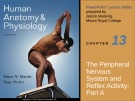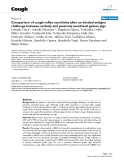
Reflex activity
-
In this chapter, you will learn to: Define peripheral nervous system and list its components; classify general sensory receptors by structure, stimulus detected, and body location; outline the events that lead to sensation and perception; describe receptor and generator potentials and sensory adaptation; describe the main aspects of sensory perception.
 40p
40p  tangtuy07
tangtuy07
 02-04-2016
02-04-2016
 56
56
 2
2
 Download
Download
-
The peripheral nervous system and reflex activity (part c) provides knowledge of spinal nerves. The goal is for you to learn: Describe the formation of a spinal nerve and the general distribution of its rami; define plexus, name the major plexuses and describe the distribution and function of the peripheral nerves arising from each plexus.
 28p
28p  tangtuy07
tangtuy07
 02-04-2016
02-04-2016
 50
50
 4
4
 Download
Download
-
Chapter 13 - The peripheral nervous system and reflex activity (part b). This chapter define ganglion and indicate the general body location of ganglia, describe the general structure of a nerve, follow the process of nerve regeneration, name the 12 pairs of cranial nerves, indicate the body region and structures innervated by each.
 30p
30p  tangtuy07
tangtuy07
 02-04-2016
02-04-2016
 49
49
 3
3
 Download
Download
-
Chapter 13 (part d) provides knowledge of motor endings and motor activity. In this chapter, students will be able to compare and contrast the motor endings of somatic and autonomic nerve fibers, outline the three levels of the motor hierarchy, compare the roles of the cerebellum and basal nuclei in controlling motor activity.
 55p
55p  tangtuy07
tangtuy07
 02-04-2016
02-04-2016
 62
62
 3
3
 Download
Download
-
Tuyển tập các báo cáo nghiên cứu về y học được đăng trên tạp chí y học Critical Care giúp cho các bạn có thêm kiến thức về ngành y học đề tài: Comparison of cough reflex sensitivity after an inhaled antigen challenge between actively and passively sensitized guinea pigs...
 8p
8p  coxanh_4
coxanh_4
 26-10-2011
26-10-2011
 43
43
 3
3
 Download
Download
-
Lower Motor Neuron Weakness This pattern results from disorders of cell bodies of lower motor neurons in the brainstem motor nuclei and the anterior horn of the spinal cord, or from dysfunction of the axons of these neurons as they pass to skeletal muscle (Fig. 232). Weakness is due to a decrease in the number of muscle fibers that can be activated, through a loss of α motor neurons or disruption of their connections to muscle. Loss of γmotor neurons does not cause weakness but decreases tension on the muscle spindles, which decreases muscle tone and attenuates the stretch reflexes...
 5p
5p  ongxaemnumber1
ongxaemnumber1
 29-11-2010
29-11-2010
 67
67
 3
3
 Download
Download
-
Disorders of Vascular Tone or Blood Volume Disorders of vascular tone or blood volume that can cause syncope include the reflex syncopes and a number of conditions resulting in orthostatic intolerance. The reflex syncopes—including neurocardiogenic syncope, situational syncope, and carotid sinus hypersensitivity—share common autonomic nervous system pathophysiologic mechanisms: a cardioinhibitory component (e.g., bradycardia due to increased vagal activity), a vasodepressor component (e.g., inappropriate vasodilatation due to sympathetic withdrawal), or both.
 5p
5p  ongxaemnumber1
ongxaemnumber1
 29-11-2010
29-11-2010
 59
59
 2
2
 Download
Download
-
Sympathetically Maintained Pain Patients with peripheral nerve injury can develop a severe burning pain (causalgia) in the region innervated by the nerve. The pain typically begins after a delay of hours to days or even weeks. The pain is accompanied by swelling of the extremity, periarticular osteoporosis, and arthritic changes in the distal joints. The pain is dramatically and immediately relieved by blocking the sympathetic innervation of the affected extremity.
 9p
9p  ongxaemnumber1
ongxaemnumber1
 26-11-2010
26-11-2010
 72
72
 4
4
 Download
Download
-
Vasodilators alogues such as iloprost, or prostaglandin E1 analogues such as alprostanil, mimic the actions of relaxant mediators. Ca2+ antagonists reduce depolarizing inward Ca2+ currents, while K+-channel activators promote outward (hyperpolarizing) K+ currents. Organic nitrovasodilators give rise to NO, an endogenous activator of guanylate cyclase. Individual vasodilators. Nitrates (p. 120) Ca2+-antagonists (p. 122). "1antagonists (p. 90), ACE-inhibitors, AT1antagonists (p. 124); and sodium nitroprusside (p. 120) are discussed elsewhere.
 6p
6p  bigbaby87
bigbaby87
 04-09-2010
04-09-2010
 76
76
 8
8
 Download
Download
CHỦ ĐỀ BẠN MUỐN TÌM





















